Ductility Variation and Improvement of Strain-Hardening Cementitious Composites in Structural Utilization
Abstract
1. Introduction
2. Materials and Methods
2.1. Mix Design of the SHCC Material
2.2. Specimen Characteristics
2.2.1. Dumbbell-Shaped SHCC Specimens for the Uniaxial Tension Tests
2.2.2. Specimens of the Shear-Failed SHCC Member
2.2.3. Specimens of the Flexural-Failed SHCC Member with and without Steel Reinforcement
3. Results and Discussion
3.1. Behavior of the SHCC Material in the Uniaxial Tension Test
3.2. Ductility of the Shear-Failed SHCC Member Compared to That of the SHCC Material under Uniaxial Tension
3.3. Ductility of the Flexural-Failed SHCC Member without Steel Reinforcement Compared to That of the SHCC Material under Uniaxial Tension
3.4. Behavior of the Flexural-Failed SHCC Member with Steel Reinforcement
3.4.1. Load-Displacement Curves
3.4.2. Cracking Behavior and Patterns
4. Conclusions
- (1)
- The SHCC material in the uniaxial tension test using dumbbell-shaped specimens of small size exhibited an excellent strain-hardening capacity, with significant multi-cracking performance originating from multiple fine cracks that occurred and propagated following an initial crack. This was dominated by the fiber bridging effect of the matching between the cement matrix and the fibers in the SHCC material, which is significantly influenced by not only the fiber distribution within each section of the SHCC material but also the variation in the fiber content among the different sections.
- (2)
- The crack elongation performance of the shear-failed SHCC member was significantly reduced compared to that of the dumbbell-shaped SHCC specimens of small size subject to the uniaxial tension test. For the shear-failed SHCC member, the aforementioned multiple fine cracks were distributed within a limited range along the direction of the diagonal shear, whereas they were almost evenly distributed across the whole dumbbell-shaped SHCC specimens of small size. However, the measured crack spacing of the multiple fine cracks across the shear span of the shear-failed SHCC member was about 3 mm, and this was similar to that of the dumbbell-shaped SHCC specimens in the uniaxial tension test. This implies that the limited range along the diagonal shear direction of the shear-failed SHCC members retained its multi-cracking performance in the uniaxial tension test.
- (3)
- The multi-cracking performance of the flexural-failed SHCC members was obviously reduced compared to that of the small dumbbell-shaped SHCC specimens in the uniaxial tension test. This illustrates the significant ductility reduction of SHCC in structural utilization since the bridging effect of the short fibers in the flexural-failed SHCC member significantly varied from that of the small dumbbell-shaped specimens under uniaxial tension; the fiber bridging effect in each section of the SHCC specimens correlated with all the nearby fibers and, thus, continuously changed.
- (4)
- The flexural-failed SHCC member without steel reinforcement also experienced multi-cracking processes, with multiple and localized flexural fine cracks appearing in the SHCC member prior to the final failure. However, the multi-cracking performance of the flexural-failed SHCC member without steel reinforcement was significantly reduced compared to that of the SHCC material in the uniaxial tension tests using the dumbbell-shaped specimen of small size. This was probably induced by the aforementioned continuously changing fiber bridging effect in the SHCC member without steel reinforcement.
- (5)
- Steel reinforcement can effectively increase the crack elongation performance with the multi-cracking phenomenon in flexural-failed SHCC members. The average cracking spacing was effectively reduced by an increase in the reinforcement ratio of the flexural-failed SHCC member with steel reinforcement. Moreover, the load-bearing capacity of the flexural-failed SHCC member with steel reinforcement seemed to increase linearly with an increase in the reinforcement ratio. This was probably caused by the enhanced strain-hardening capacity of these members as a result of their improved multi-cracking performance.
Author Contributions
Funding
Institutional Review Board Statement
Informed Consent Statement
Data Availability Statement
Conflicts of Interest
References
- Choo, C.C.; Harik, I.E.; Gesund, H. Minimum reinforcement ratio for fiber-reinforced polymer reinforced concrete rectangular columns. ACI Struct. J. 2006, 103, 460–466. [Google Scholar]
- Abbas, A.A.; Mohsin, S.M.S.; Cotsovos, D.M. A simplified finite element model for assessing steel fibre reinforced concrete structural performance. Comput. Struct. 2016, 173, 31–49. [Google Scholar] [CrossRef]
- Bazant, Z.P. A Concrete fracture models: Testing and practice. Eng. Fract. Mech. 2002, 69, 165–205. [Google Scholar] [CrossRef]
- Banthia, N.; Zanotti, C.; Sappakittipakorn, M. Sustainable fiber reinforced concrete for repair applications. Constr. Build. Mater. 2014, 67, 405–412. [Google Scholar] [CrossRef]
- Ding, L.N.; Liu, L.L.; Wang, X.; Shen, H.B.; Wu, Z.S. Effects of connecting materials on the static and fatigue behavior of pultruded basalt fiber-reinforced polymer bolted joints. Constr. Build. Mater. 2021, 273, 121683. [Google Scholar] [CrossRef]
- Zou, X.; Mirala, A.; Sneed, L.H.; Ghasr, M.T.; Donnell, K.M. Debonding detection of defected CFRP-concrete interface using microwave thermography. Compos. Struct. 2023, 310, 116753. [Google Scholar] [CrossRef]
- Martinola, G.; Meda, A.; Plizzari, G.A.; Rinaldi, Z. Strengthening and repair of RC beams with fiber reinforced concrete. Cem. Concr. Compos. 2010, 32, 731–739. [Google Scholar] [CrossRef]
- Suryanto, B.; Nagai, K.; Maekawa, K. Smeared-crack modeling of R/ECC membranes incorporating an explicit shear transfer model. J. Adv. Concr. Technol. 2010, 8, 315–326. [Google Scholar] [CrossRef]
- Chu, H.Y.; Zhang, Y.; Wang, F.J.; Feng, T.T.; Wang, L.G.; Wang, D.Q. Effect of graphene oxide on mechanical properties and durability of ultra-high-performance concrete prepared from recycled sand. Nanomaterials 2020, 10, 1718. [Google Scholar] [CrossRef] [PubMed]
- Figueiredo, S.C.; Rodríguez, C.R.; Ahmed, Z.Y.; Bos, D.H.; Xu, Y.D.; Salet, T.M.; Çopuroğlu, O.; Schlangen, E.; Bos, F.P. Mechanical behavior of printed strain hardening cementitious composites. Materials 2020, 13, 2253. [Google Scholar] [CrossRef] [PubMed]
- Boshoff, W.P.; Zijl, G.P.A.G. A computational model for strain-hardening fibre-reinforced cement based composites. J. S. Afr. Inst. Civ. Eng. 2007, 49, 24–31. [Google Scholar]
- Shin, S.K.; Kim, J.J.H.; Lim, Y.M. strengthening effect of DFRCC applied to plain concrete beams. Cem. Concr. Compos. 2007, 29, 465–473. [Google Scholar] [CrossRef]
- Zhang, Y.X.; Bai, S.; Zhang, Q.B. Investigation of localised behaviour of strain-hardening cementitious composites for RC strengthening. Adv. Cem. Res. 2016, 28, 414–421. [Google Scholar] [CrossRef]
- Choi, H.K.; Bae, B.I.; Choi, C.S. Lateral resistance of unreinforced masonry walls strengthened with engineered cementitious composite. Int. J. Civ. Eng. 2016, 14, 411–424. [Google Scholar] [CrossRef]
- Mahmoud, M.H.; Afefy, H.M.; Baraghith, A.T.; Elnagar, A.B. Impact and static behavior of strain-hardening cementitious composites–strengthened reinforced concrete slabs. Adv. Struct. Eng. 2020, 23, 1614–1628. [Google Scholar] [CrossRef]
- Zhang, Y.X.; Bai, S.; Zhang, Q.B.; Xie, H.B.; Zhang, X.M. Failure behavior of strain hardening cementitious composites for shear strengthening RC member. Constr. Build. Mater. 2015, 78, 470–473. [Google Scholar] [CrossRef]
- Lu, C.; Leung, C.K.Y. Effect of fiber content variation on the strength of the weakest section in strain hardening cementitious composites (SHCC). Constr. Build. Mater. 2017, 141, 253–258. [Google Scholar] [CrossRef]
- Paul, S.C.; Pirskawetz, S.; Zijl, G.P.A.G.; Schmidt, W. Acoustic emission for characterising the crack propagation in strain-hardening cement-based composites (SHCC). Cem. Concr. Res. 2015, 69, 19–24. [Google Scholar] [CrossRef]


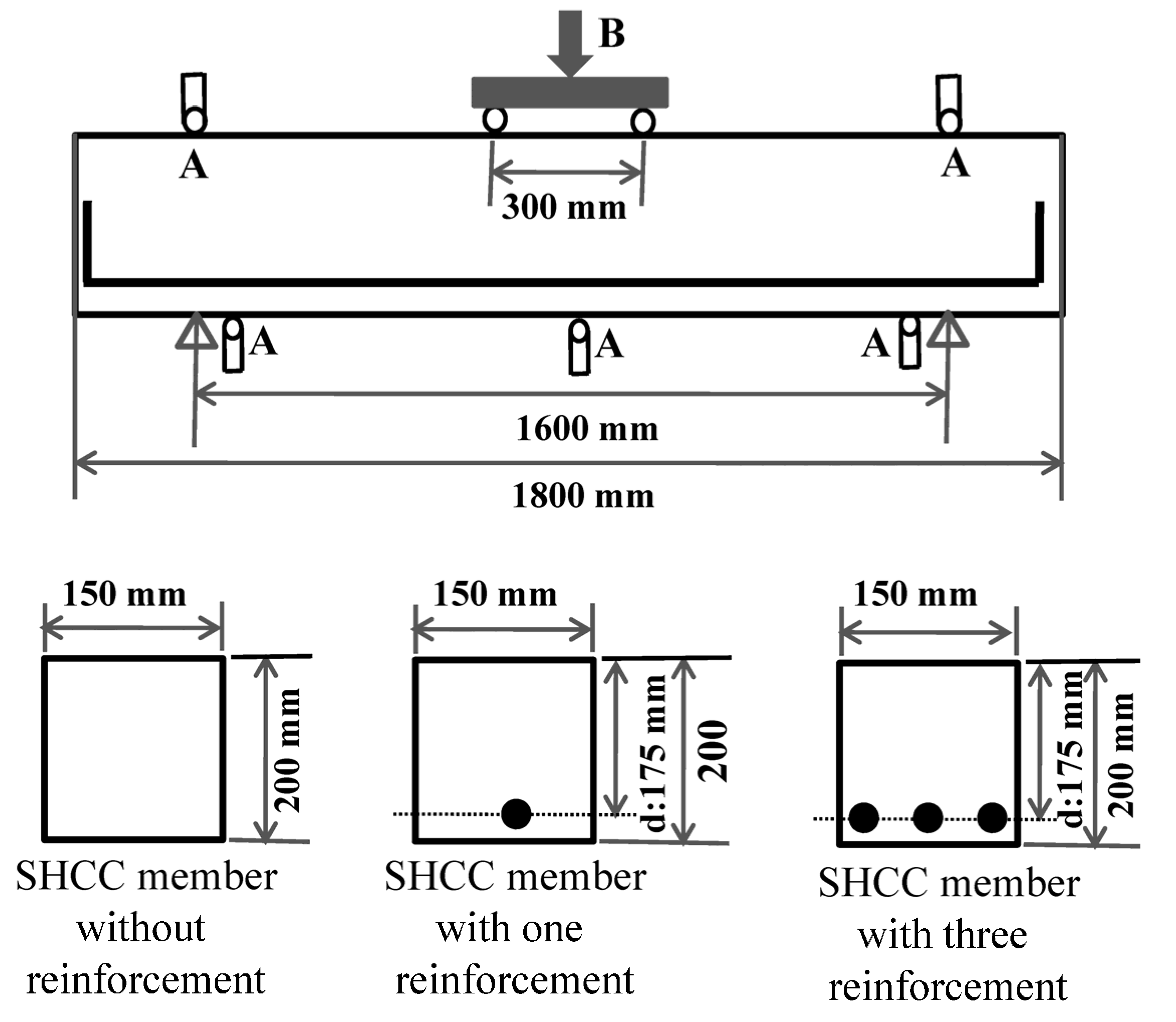


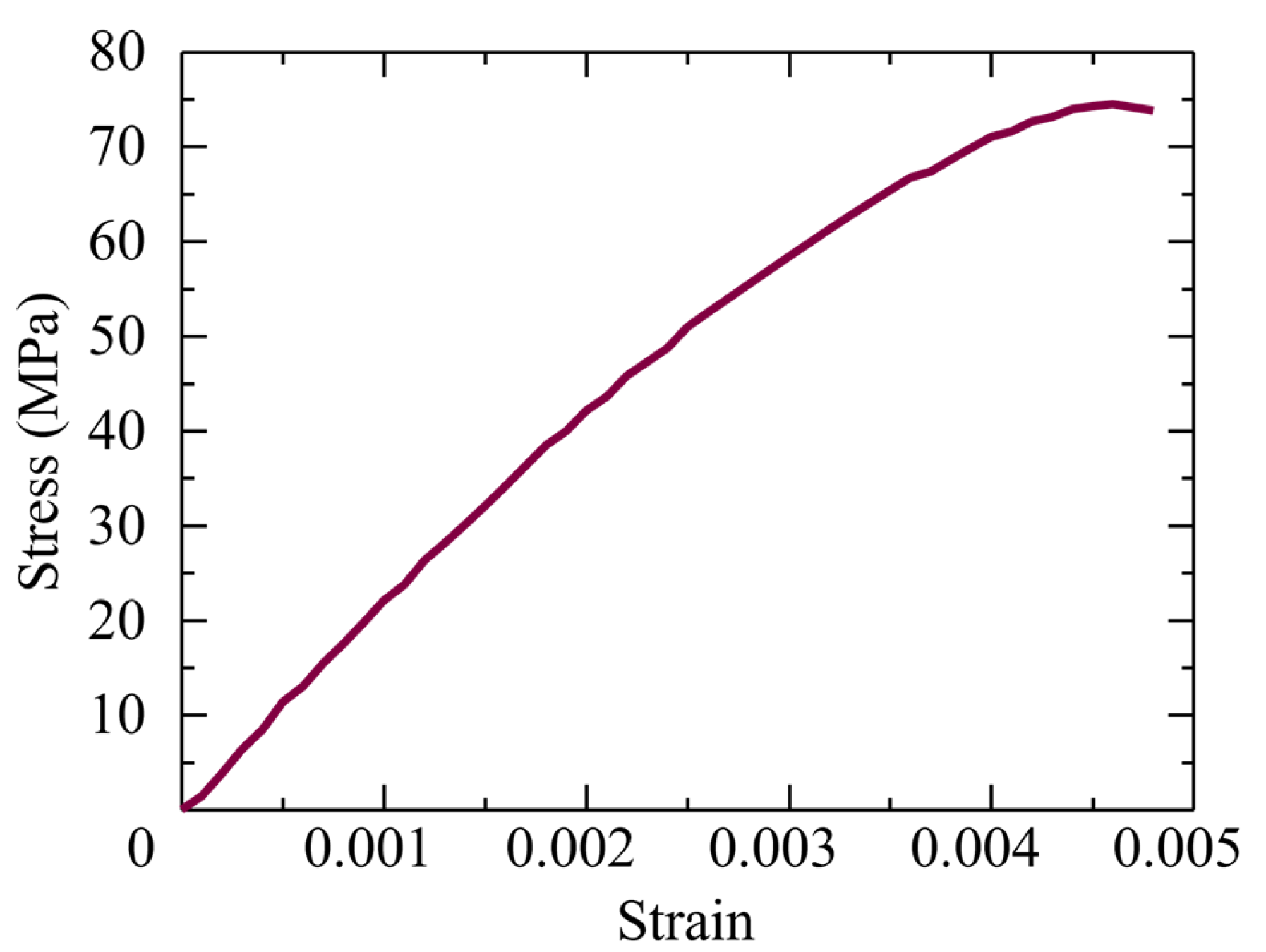
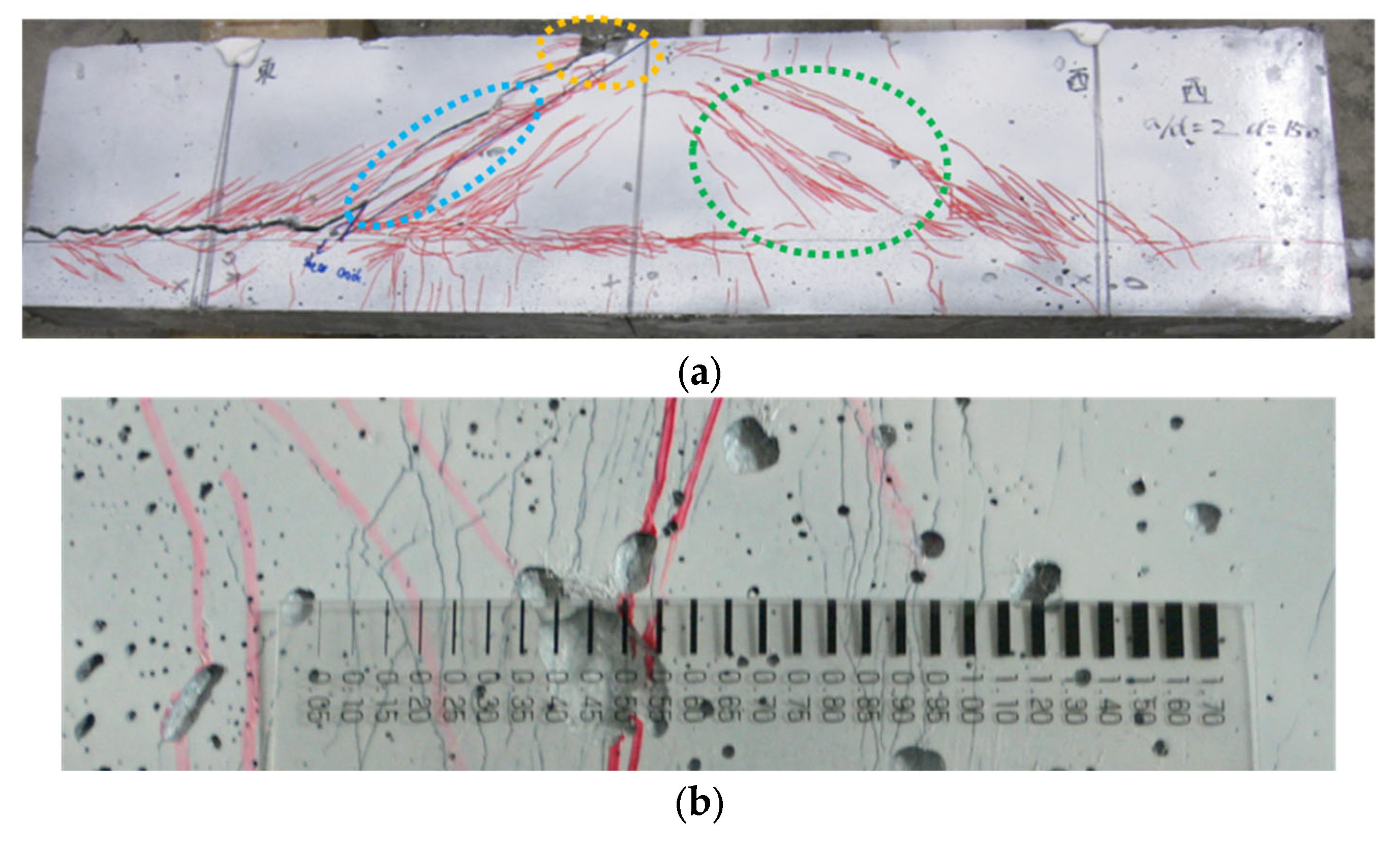
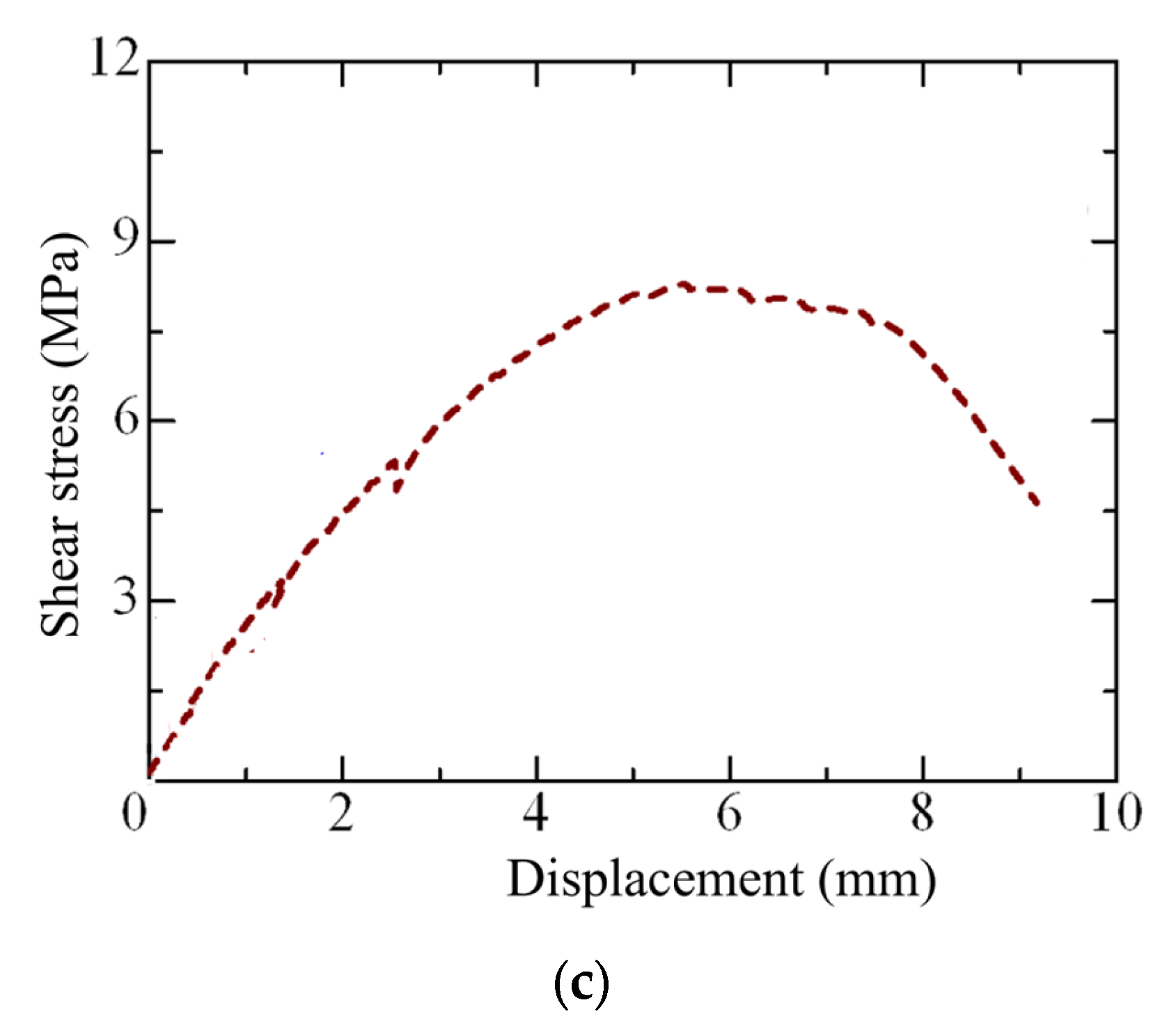
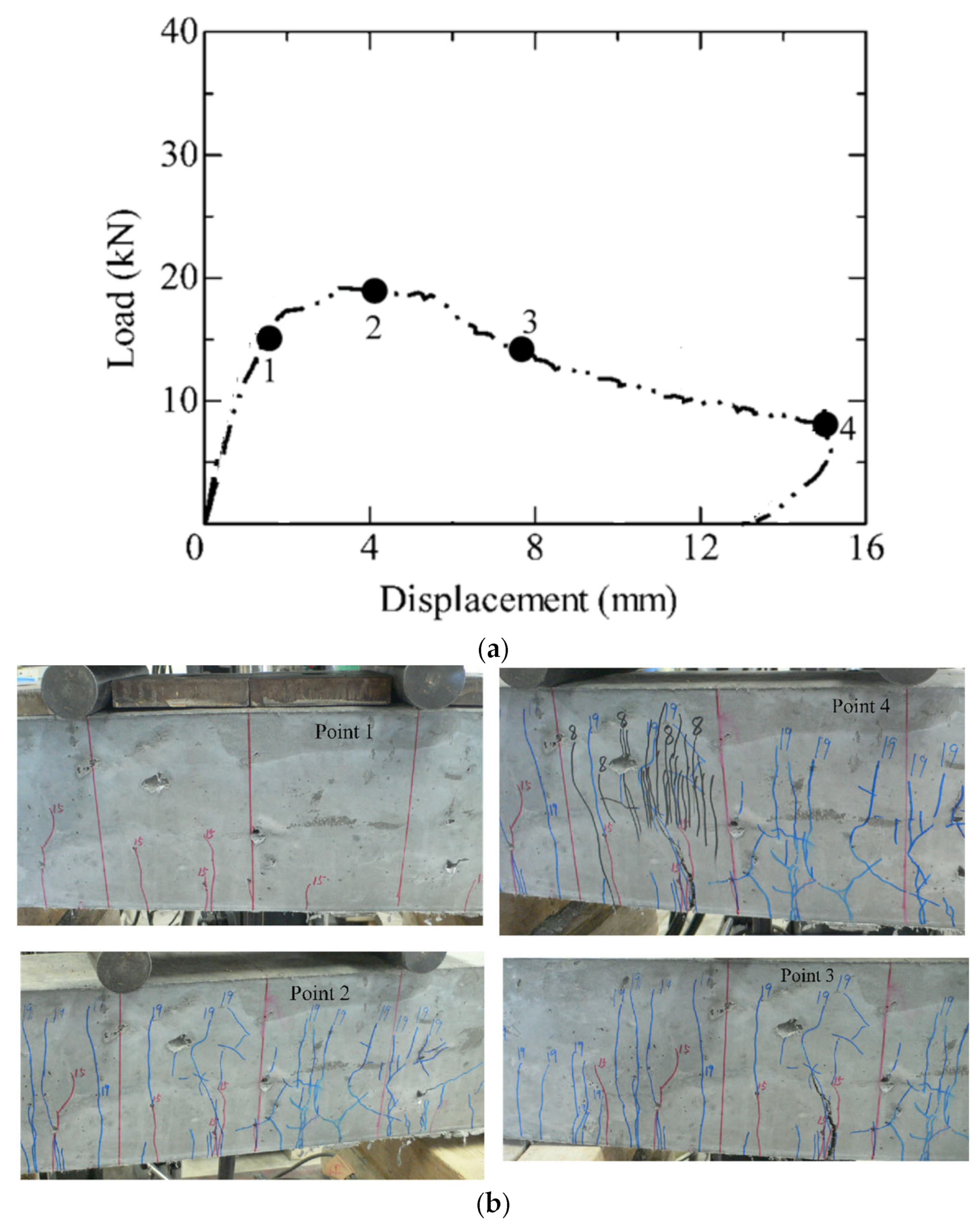
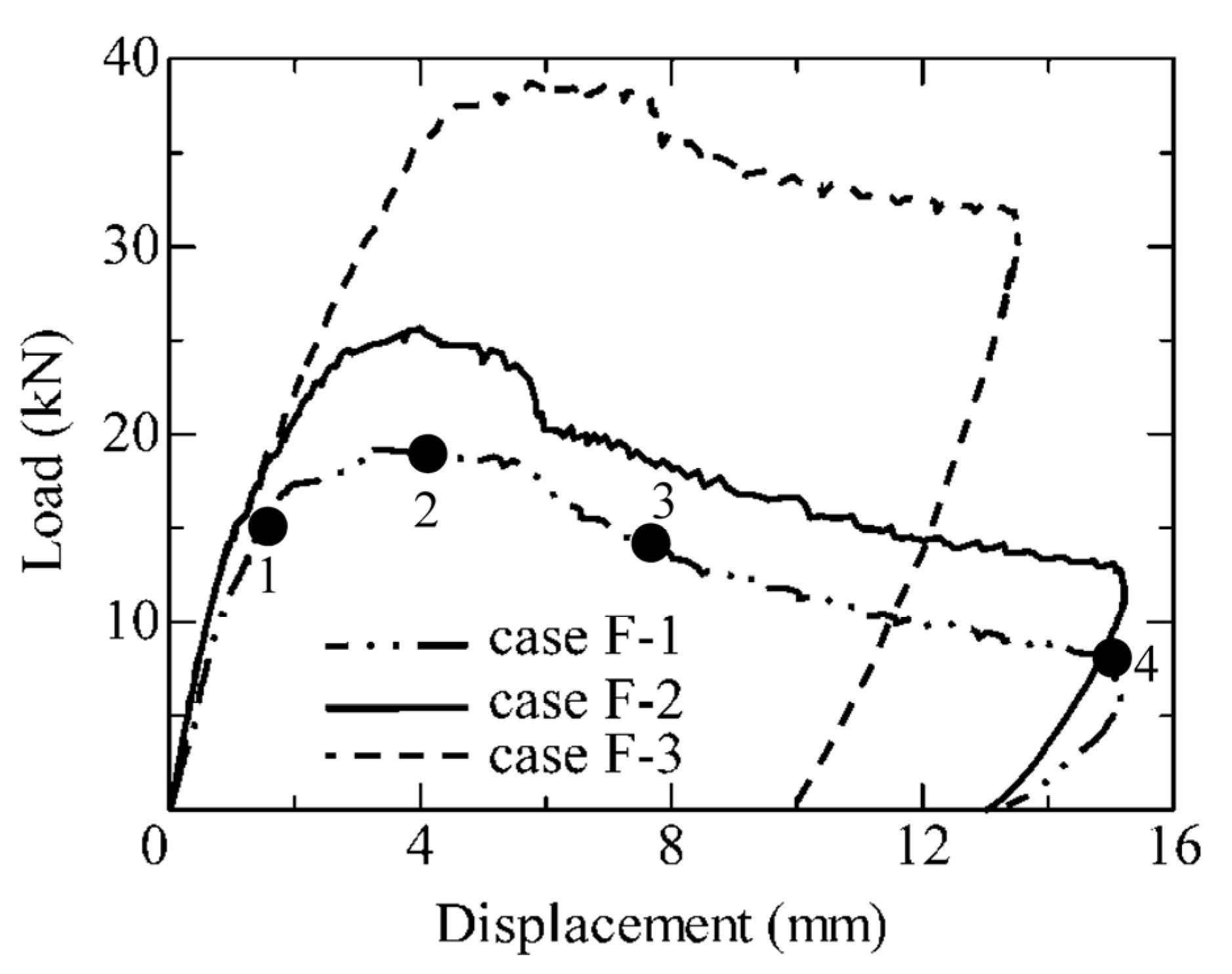
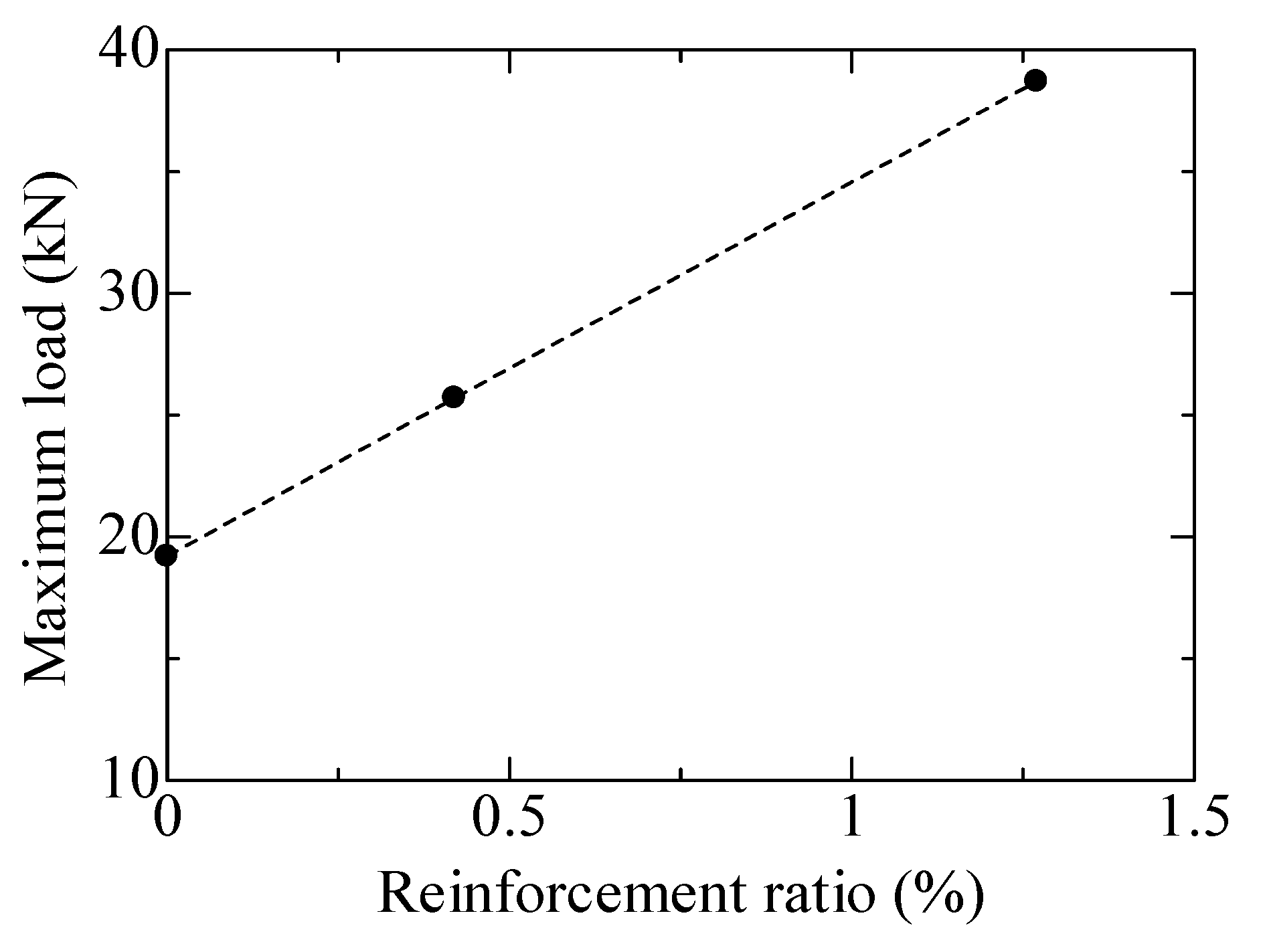

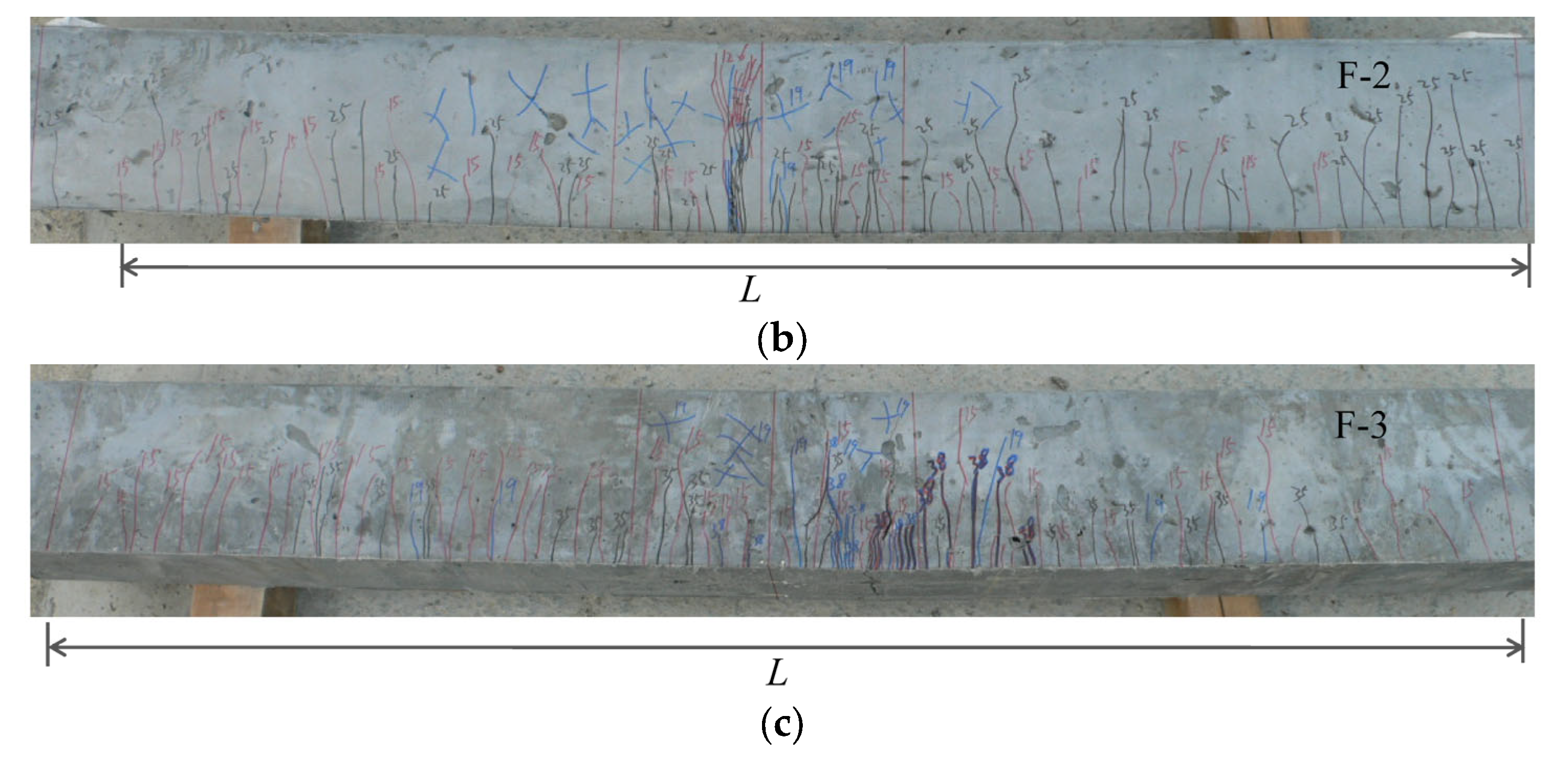
| Water/ Binder | Unit Content (kg/m3) | |||||||
|---|---|---|---|---|---|---|---|---|
| Water | Cement | Silica Fume | Fine Sand | PE Fiber | Expansion Agent | Superplasticizer | Air Reducing Agent | |
| 0.22 | 338.5 | 1267.9 | 230.8 | 153.9 | 14.6 | 40.0 | 15.4 | 0.06 |
| Specimen | ρs (%) | n | L (mm) | Sav (mm) |
|---|---|---|---|---|
| F-1 | 0 | 33 | 810 | 24.6 |
| F-2 | 0.42 | 76 | 1511 | 19.9 |
| F-3 | 1.27 | 96 | 1600 | 16.7 |
| uniaxial tension | 0 | 38 | 100 | 2.6 |
Disclaimer/Publisher’s Note: The statements, opinions and data contained in all publications are solely those of the individual author(s) and contributor(s) and not of MDPI and/or the editor(s). MDPI and/or the editor(s) disclaim responsibility for any injury to people or property resulting from any ideas, methods, instructions or products referred to in the content. |
© 2024 by the authors. Licensee MDPI, Basel, Switzerland. This article is an open access article distributed under the terms and conditions of the Creative Commons Attribution (CC BY) license (https://creativecommons.org/licenses/by/4.0/).
Share and Cite
Diao, P.; Ling, Z.; Bai, Y.; Lu, W.; Zhang, Y. Ductility Variation and Improvement of Strain-Hardening Cementitious Composites in Structural Utilization. Materials 2024, 17, 831. https://doi.org/10.3390/ma17040831
Diao P, Ling Z, Bai Y, Lu W, Zhang Y. Ductility Variation and Improvement of Strain-Hardening Cementitious Composites in Structural Utilization. Materials. 2024; 17(4):831. https://doi.org/10.3390/ma17040831
Chicago/Turabian StyleDiao, Pinxin, Zongyou Ling, Yunbo Bai, Weihua Lu, and Yongxing Zhang. 2024. "Ductility Variation and Improvement of Strain-Hardening Cementitious Composites in Structural Utilization" Materials 17, no. 4: 831. https://doi.org/10.3390/ma17040831
APA StyleDiao, P., Ling, Z., Bai, Y., Lu, W., & Zhang, Y. (2024). Ductility Variation and Improvement of Strain-Hardening Cementitious Composites in Structural Utilization. Materials, 17(4), 831. https://doi.org/10.3390/ma17040831










